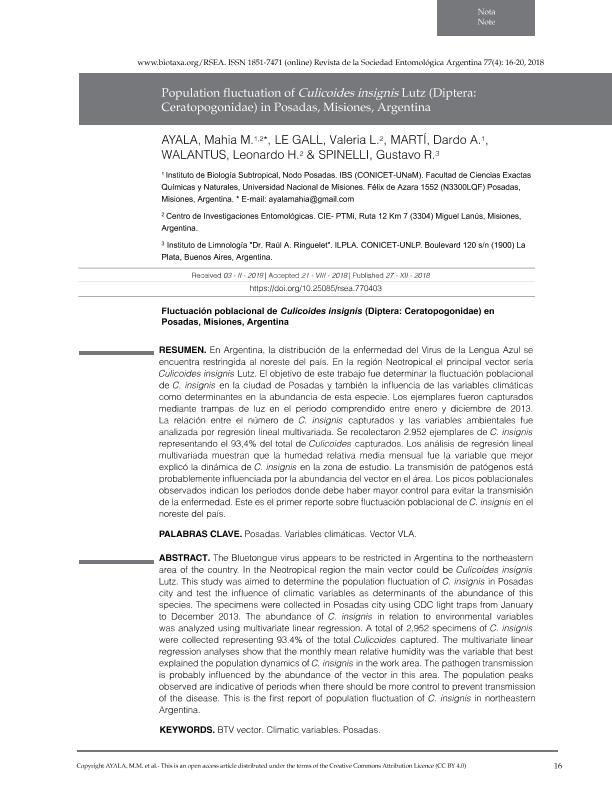Mostrar el registro sencillo del ítem
dc.contributor.author
Ayala, Mahia Mariel

dc.contributor.author
Le Gall, Valeria Lis

dc.contributor.author
Marti, Dardo Andrea

dc.contributor.author
Walantus, Leonardo Horacio

dc.contributor.author
Spinelli, Gustavo Ricardo

dc.date.available
2019-11-27T13:57:21Z
dc.date.issued
2018-12
dc.identifier.citation
Ayala, Mahia Mariel; Le Gall, Valeria Lis; Marti, Dardo Andrea; Walantus, Leonardo Horacio; Spinelli, Gustavo Ricardo; Population fluctuation of Culicoides insignis Lutz (Diptera: Ceratopogonidae) in Posadas, Misiones, Argentina; Sociedad Entomológica Argentina; Revista de la Sociedad Entomológica Argentina; 77; 4; 12-2018; 16-20
dc.identifier.issn
1851-7471
dc.identifier.uri
http://hdl.handle.net/11336/90633
dc.description.abstract
En Argentina, la distribución de la enfermedad del Virus de la Lengua Azul se encuentra restringida al noreste del país. En la región Neotropical el principal vector sería Culicoides insignis Lutz. El objetivo de este trabajo fue determinar la fluctuación poblacional de C. insignis en la ciudad de Posadas y también la influencia de las variables climáticas como determinantes en la abundancia de esta especie. Los ejemplares fueron capturados mediante trampas de luz en el período comprendido entre enero y diciembre de 2013. La relación entre el número de C. insignis capturados y las variables ambientales fue analizada por regresión lineal multivariada. Se recolectaron 2.952 ejemplares de C. insignis representando el 93,4% del total de Culicoides capturados. Los análisis de regresión lineal multivariada muestran que la humedad relativa media mensual fue la variable que mejor explicó la dinámica de C. insignis en la zona de estudio. La transmisión de patógenos está probablemente influenciada por la abundancia del vector en el área. Los picos poblacionales observados indican los períodos donde debe haber mayor control para evitar la transmisión de la enfermedad. Este es el primer reporte sobre fluctuación poblacional de C. insignis en el noreste del país.
dc.description.abstract
The Bluetongue virus appears to be restricted in Argentina to the northeasternarea of the country. In the Neotropical region the main vector could be Culicoides insignis Lutz. This study was aimed to determine the population fluctuation of C. insignis in Posadas city and test the influence of climatic variables as determinants of the abundance of this species. The specimens were collected in Posadas city using CDC light traps from January to December 2013. The abundance of C. insignis in relation to environmental variables was analyzed using multivariate linear regression. A total of 2,952 specimens of C. insigniswere collected representing 93.4% of the total Culicoides captured. The multivariate linear regression analyses show that the monthly mean relative humidity was the variable that best explained the population dynamics of C. insignis in the work area. The pathogen transmission is probably influenced by the abundance of the vector in this area. The population peaks observed are indicative of periods when there should be more control to prevent transmissionof the disease. This is the first report of population fluctuation of C. insignis in northeastern Argentina.
dc.format
application/pdf
dc.language.iso
eng
dc.publisher
Sociedad Entomológica Argentina

dc.rights
info:eu-repo/semantics/openAccess
dc.rights.uri
https://creativecommons.org/licenses/by-nc-sa/2.5/ar/
dc.subject
BTV VECTOR
dc.subject
CULICOIDES INSIGNIS
dc.subject
CLIMATE VARIABLE
dc.subject
POSADAS
dc.subject.classification
Zoología, Ornitología, Entomología, Etología

dc.subject.classification
Ciencias Biológicas

dc.subject.classification
CIENCIAS NATURALES Y EXACTAS

dc.title
Population fluctuation of Culicoides insignis Lutz (Diptera: Ceratopogonidae) in Posadas, Misiones, Argentina
dc.title
Fluctuación poblacional de Culicoides insignis (Diptera: Ceratopogonidae) en Posadas, Misiones, Argentina
dc.type
info:eu-repo/semantics/article
dc.type
info:ar-repo/semantics/artículo
dc.type
info:eu-repo/semantics/publishedVersion
dc.date.updated
2019-10-18T15:48:17Z
dc.journal.volume
77
dc.journal.number
4
dc.journal.pagination
16-20
dc.journal.pais
Argentina

dc.description.fil
Fil: Ayala, Mahia Mariel. Consejo Nacional de Investigaciones Científicas y Técnicas. Centro Científico Tecnológico Conicet - Nordeste. Instituto de Biología Subtropical. Universidad Nacional de Misiones. Instituto de Biología Subtropical; Argentina
dc.description.fil
Fil: Le Gall, Valeria Lis. Centro de Investigaciones Entomológicas; Argentina. Consejo Nacional de Investigaciones Científicas y Técnicas; Argentina
dc.description.fil
Fil: Marti, Dardo Andrea. Consejo Nacional de Investigaciones Científicas y Técnicas. Centro Científico Tecnológico Conicet - Nordeste. Instituto de Biología Subtropical. Universidad Nacional de Misiones. Instituto de Biología Subtropical; Argentina
dc.description.fil
Fil: Walantus, H.. Centro de Investigaciones Entomológicas; Argentina
dc.description.fil
Fil: Spinelli, Gustavo Ricardo. Consejo Nacional de Investigaciones Científicas y Técnicas. Centro Científico Tecnológico Conicet - La Plata. Instituto de Limnología "Dr. Raúl A. Ringuelet". Universidad Nacional de La Plata. Facultad de Ciencias Naturales y Museo. Instituto de Limnología; Argentina
dc.journal.title
Revista de la Sociedad Entomológica Argentina

dc.relation.alternativeid
info:eu-repo/semantics/altIdentifier/url/https://www.biotaxa.org/RSEA/article/view/43948
dc.relation.alternativeid
info:eu-repo/semantics/altIdentifier/doi/https://doi.org/10.25085/rsea.770403
Archivos asociados
